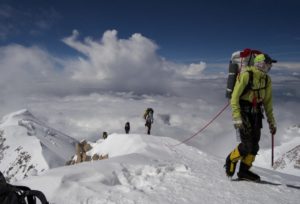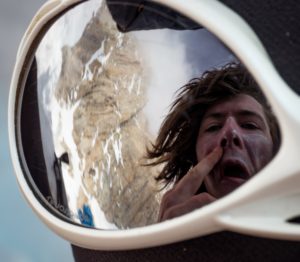How long have you been a guide? How long of that has been on Denali?
I started my guiding career in 2012 as a canoe guide in Connecticut on the small rivers there, but I didn’t start doing any climbing or mountain guiding until 2014. I started guiding on Denali in 2015, as an apprentice at the Alaska Mountaineering School based in Talkeetna, AK.
What was the process of learning how to be a Denali guide?
I’m always trying to increase my margin of skill relative to my clients/guests. In the first couple of years of climbing and mountain guiding, I was worried about – and focused on training – my technical and physical ability. I was worried that my climbing skill, strength and endurance, and rope skills wouldn’t measure up to what my clients wanted from a guide. I was especially self-conscious of my cooking skills, which is one of the most important skills in expedition guiding. As I’ve gained skill and experience, I put many tasks on “autopilot”; I don’t have to worry about burning the hashbrowns, I don’t think about how to teach a knot-tying class, and I don’t have to worry about getting tired on the trail. This gives me significantly more energy to actually focus on my clients and look for important behavioral indicators about how they are taking care of themselves over the course of the expedition, as well as how they are responding to the stresses of climbing and living in an extreme environment. By paying attention to things like that, I avoid surprises like someone unexpectedly collapsing on a descent from deep fatigue or being paralyzed by fear because I led them into a situation too far outside of their comfort zone. Improving these skills is what captures a lot of my attention now; emotional intelligence, behavioral indicators, and scaling an objective to the participant’s needs and wants.
How did you develop a love for climbing?
When I got into climbing, I found it addictive and transformative, with expeditions being especially powerful experiences because of their length and intensity. I realized that guiding would give me the chance to help others experience the same thing, and make a living while doing it. If I won the lottery, I wouldn’t be guiding on Denali, but I would still be on Denali every spring for my expedition; I figure that’s about as close as I’ll come to getting paid to do what I love.
How many times have you summited Denali?
I’ve been to the top 3 times out of 9 expeditions.
Have you ever attempted a summit and failed? What happened?
I’ve been on a few attempts and turned back during summit day. In most cases, it’s weather that turns us back. This spring we made it all the way to 20,100′ (only 200 vertical feet below the summit), basically to the last possible spot you can stop and not be on the summit. We had been able to climb mostly behind terrain that sheltered us from the strong winds all day, but the last section of the ridge crest to the summit is the highest point of the continent – so it’s exposed to the full wrath of any wind that blows. The last section was so hammered by howling winds that we expected to literally be blown off the mountain if we proceeded, so we turned around. It stung to turn around when we were so close, but as someone once told me: “That would be a dumb way to die.”
How many vertical feet – actual summits and attempts – have you completed over the years?
On Denali (forgetting all my other mountains and expeditions), I’ve climbed a total of about 187,000 vertical feet (or about 35 vertical miles). The climb from base camp to the top involves about 13,000′ (~2.5 miles) vertical feet of climbing over about 15 horizontal miles. Because of the need to acclimate to the altitude, we stretch the trip over 2-3 weeks. Our loads of group gear, personal gear, and food total 120-130 lbs per person for the trip; too much to climb. So we ferry loads up the mountain stages, carrying a load high and then returning to sleep in our lower camp. This strategy means that the team will climb all the terrain from 7,200′ to 17,200′ twice, for a total of 23,000′ of climbing per trip. My boss has been climbing Denali for about 30 years – I don’t even want to think about how many vertical feet he’s climbed!
How would you describe the feeling of summiting Denali? Does it ever get old?
I’ve had some incredible days going to the summit of Denali, with the sun shining and views that stretch as far as the eye can physically see. I’ve also had some rough summit days in a cloud, where the only indicator of the top is a small USGS survey marker stuck in the snow. Regardless of how it goes through, mostly I feel tired on top! If a team is moving well, you can expect 8 hours of climbing at altitude to reach the summit from high camp, followed by 4 hours of descent. This means 12 hours of climbing in the best case scenario. And when we get back to the tents, the guides will continue to work for a couple more hours making sure that everyone is fed and hydrated before getting into their sleeping bags. As a guide, your main jobs are to keep everyone safe and get them to the top. So it always feels good to succeed on both accounts.
What’s the craziest thing you’ve ever seen on the mountain?
People with altitude illness. An injury from trauma is a big deal in a remote setting like Denali, but at least you can bandage and splint. Altitude illness can come on fast and become deadly within a very short time. Arriving in high camp (17,200′) with my team one time, we saw a park service ranger assessing a foreign climber for cerebral edema (swelling of the brain). He could barely talk, almost couldn’t support himself on his feet, and seemed deliriously unaware of his surroundings; picture the drunkest person you’ve ever seen. Luckily the weather was nice, and the park service helicopter came to bring him to a hospital within the hour, but if he hadn’t descended soon, he would have likely died that day.
What’s the best part of your job? What’s the hardest part?
People under-estimate the West Buttress route (the “standard” route) of Denali because it’s the easiest way up the mountain, and it’s not technically difficult climbing. But it’s still really hard! A lot of people have some of the hardest experiences of their lives on the slopes of the West Buttress, and it’s awesome to watch them go through this and come out the other side transformed. I also have a great time watching teams of strangers become friends and partners over the course of an expedition, often despite what appear to be incompatible personalities. The hardest part of my job is turning people around. Some people just aren’t prepared for the demands of a Denali trip, and it’s the job of the guide to tell them when they’re not going any higher. These conversations are usually emotional and sometimes argumentative, but [it’s] always the thing I dread most of the whole expedition (even more than dealing with the poop bucket!).
Marathon runners will talk about “hitting the wall” near the 20th mile. Is there anything comparable when summiting a super high peak?
We hit the wall as well, but for different reasons. Most runners finish a marathon in 2-6 hours, and their “wall” is mostly a physiological phenomenon of running out of glycogen stores in their muscles. This makes it hard to finish a race, but then they go home to eat a good dinner, relax with some TV or a book, and sleep in their bed. On our expeditions, however, “the wall” is mostly psychological. Don’t get me wrong, expeditions are physically demanding, but the largest strain is on the mind. The shortest day of climbing on the West Buttress is about 6 hours of climbing, with the average day being 8-10 hours, and summit day being 12-18 hours. We typically do this for several days in a row without a rest day, and then sleep in tents on a glacier every night. People hit the wall on these expeditions because they don’t exercise the discipline to take care of themselves, or don’t have the patience to sit out the famous two weeks storms that can trap you in your tent. After a week or two waiting out a storm, soggy and cold, many climbers are happy to escape downward toward home instead of trying to continue up the mountain.
What unusual items do you keep in your backpack?
I guess the most unusual thing in my pack is a wood spoon I carved myself. It weighs the same as a titanium one, but because it’s wood it doesn’t conduct cold or heat to my lips; I never have to re-enact the flagpole scene from “A Christmas Story” with my tongue on cold metal or burn my tongue with an especially hot soup. Mostly, though, it’s nice to hold a little bit of organic material in a world of ice and rock and nylon.
I’ve heard that mountain guides often bring candy stashes for quick energy — is that your style? What is your candy of choice?
My first few trips I brought almost exclusively candy bars for trail food – 22 pounds of snickers and Reese’s gets old after a couple weeks! And health-wise, that’s fine when you’re only doing one expedition a year, but it’s not really good for you when you’re doing it months out of the year. Going on so many expeditions I’ve actually shifted to more nuts and dried fruits for trail food to try to be a little healthier. But I still always bring a few Reese’s cups – they don’t freeze solid in the cold, and I can always stomach them even at altitude.
What are a few of your favorite stories about guiding? Was there one expedition that stood out more than others?
I can’t pick out a single trip that was better than others; they are all so great and difficult in their own ways. But my best experiences have always had to do with clients who go above and beyond, who care about their guides as humans and not just members of the service industry. I’ve left camp for a rescue (of another team; it turns out they were fine, just slow coming back to camp) and returned to a bowl of dinner and a thermos of hot water, prepared by the clients. I had one client who I stayed behind with when the rest of the team went for a summit bid – she couldn’t keep her toes warm while climbing – who begged me to leave her alone and catch up with the group because she didn’t want me to miss out on summiting because of her. Almost every climber from these expeditions offered their hospitality if I’m ever in “their neck of the woods.” These are the kinds of experiences that make the hard moments of an expedition bearable.


